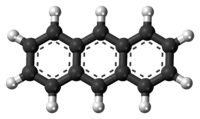Anthracene
 | |
 | |
| | |
| Names | |
|---|---|
| Preferred IUPAC name
Anthracene | |
| Systematic IUPAC name
Tricyclo[8.4.0.03,8]tetradeca-1,3,5,7,9,11,13-heptaene | |
| Identifiers | |
| 120-12-7 | |
| 3D model (Jmol) | Interactive image Interactive image |
| 1905429 | |
| ChEBI | CHEBI:35298 |
| ChEMBL | ChEMBL333179 |
| ChemSpider | 8111 |
| DrugBank | DB07372 |
| ECHA InfoCard | 100.003.974 |
| EC Number | 217-004-5 |
| 67837 | |
| KEGG | C14315 |
| PubChem | 8418 |
| RTECS number | CA9350000 |
| UNII | EH46A1TLD7 |
| |
| |
| Properties | |
| C14H10 | |
| Molar mass | 178.23 g·mol−1 |
| Appearance | Colorless |
| Odor | Weak aromatic |
| Density | 1.28 g/cm3 (25 °C)[1] 0.969 g/cm3 (220 °C) |
| Melting point | 215.76 °C (420.37 °F; 488.91 K) at 760 mmHg[1] |
| Boiling point | 339.9 °C (643.8 °F; 613.0 K) at 760 mmHg[1] |
| 0.022 mg/L (0 °C) 0.044 mg/L (25 °C) 0.287 mg/L (50 °C) 0.00045% w/w (100 °C, 3.9 MPa)[1] | |
| Solubility | Soluble in alcohol, (C2H5)2O, acetone, C6H6, CHCl3,[1] CS2[2] |
| Solubility in ethanol | 0.076 g/100 g (16 °C) 1.9 g/100 g (19.5 °C) 0.328 g/100 g (25 °C)[2] |
| Solubility in methanol | 1.8 g/100 g (19.5 °C)[2] |
| Solubility in hexane | 0.37 g/100 g[2] |
| Solubility in toluene | 0.92 g/100 g (16.5 °C) 12.94 g/100 g (100 °C)[2] |
| Solubility in carbon tetrachloride | 0.732 g/100 g[2] |
| log P | 4.56[1] |
| Vapor pressure | 0.01 kPa (125.9 °C) 0.1 kPa (151.5 °C)[1] 13.4 kPa (250 °C)[3] |
| Henry's law constant (kH) |
0.039 L·atm/mol[1] |
| UV-vis (λmax) | 345.6 nm, 363.2 nm[3] |
| Thermal conductivity | 0.1416 W/m·K (240 °C) 0.1334 W/m·K (270 °C) 0.1259 W/m·K (300 °C)[4] |
| Viscosity | 0.602 cP (240 °C) 0.498 cP (270 °C) 0.429 cP (300 °C)[4] |
| Structure | |
| Monoclinic (290 K)[5] | |
| P21/b[5] | |
| C5 2h[5] | |
| α = 90°, β = 124.7°, γ = 90° | |
| Thermochemistry | |
| 210.5 J/mol·K[1][3] | |
| Std molar entropy (S |
207.5 J/mol·K[1][3] |
| Std enthalpy of formation (ΔfH |
129.2 kJ/mol[1][3] |
| Std enthalpy of combustion (ΔcH |
7061 kJ/mol[3] |
| Hazards | |
| GHS pictograms |   [6] [6] |
| GHS signal word | Warning |
| H315, H319, H335, H410[6] | |
| P261, P273, P305+351+338, P501[6] | |
| EU classification (DSD) |
|
| R-phrases | R36/37/38, R50/53 |
| S-phrases | S26, S60, S61 |
| NFPA 704 | |
| Flash point | 121 °C (250 °F; 394 K)[6] |
| 540 °C (1,004 °F; 813 K)[6] | |
| Lethal dose or concentration (LD, LC): | |
| LD50 (median dose) |
4900 mg/kg (rats, oral) |
| Except where otherwise noted, data are given for materials in their standard state (at 25 °C [77 °F], 100 kPa). | |
| | |
| Infobox references | |
Anthracene is a solid polycyclic aromatic hydrocarbon (PAH) of formula C14H10, consisting of three fused benzene rings. It is a component of coal tar. Anthracene is used in the production of the red dye alizarin and other dyes. Anthracene is colorless but exhibits a blue (400-500 nm peak) fluorescence under ultraviolet radiation.[8]
Occurrence and production
Coal tar, which contains around 1.5% anthracene, remains a major source of this material. Common impurities are phenanthrene and carbazole. A classic laboratory method for the preparation of anthracene is by cyclodehydration of o-methyl- or o-methylene-substituted diarylketones in the so-called Elbs reaction.
It may also occur in the interstellar medium.[9] More than 20% of the carbon in the universe may be associated with PAHs, including anthracene.[10]
Reactions
Anthracene photodimerizes by the action of UV light:
The dimer, called dianthracene (or sometimes paranthracene), is connected by a pair of new carbon-carbon bonds, the result of the [4+4] cycloaddition. It reverts to anthracene thermally or with UV irradiation below 300 nm. Substituted anthracene derivatives behave similarly. The reaction is affected by the presence of oxygen.[11][12]
Reduction of anthracene with alkali metals yields the deeply colored radical anion salts M+[anthracene]− (M = Li, Na, K). Hydrogenation gives 9,10-dihydroanthracene, preserving the aromaticity of the two flanking rings.
Chemical oxidation occurs readily, giving anthraquinone, C14H8O2 (below), for example using hydrogen peroxide and vanadyl acetylacetonate.[13]
Anthracene also reacts with dienophile singlet oxygen in a [4+2]-cycloaddition (Diels–Alder reaction):
Uses
Anthracene is converted mainly to anthraquinone, a precursor to dyes.[14]
Niche
Anthracene, a wide band-gap organic semiconductor is used as a scintillator for detectors of high energy photons, electrons and alpha particles. Plastics, such as polyvinyltoluene, can be doped with anthracene to produce a plastic scintillator that is approximately water-equivalent for use in radiation therapy dosimetry. Anthracene's emission spectrum peaks at between 400 nm and 440 nm.
It is also used in wood preservatives, insecticides, and coating materials.
Anthracene is one of the three components (the other two being potassium perchlorate and sulfur) which are used to produce the black smoke released during a Papal Conclave.[15]
Derivatives
A variety of anthracene derivatives find specialized uses. Derivatives having a hydroxyl group are 1-hydroxyanthracene and 2-hydroxyanthracene, homologous to phenol and naphthols, and hydroxyanthracene (also called anthrol, and anthracenol)[16][17] are pharmacologically active. Anthracene may also be found with multiple hydroxyl groups, as in 9,10-dihydroxyanthracene.
Occurrence
Anthracene, as many other Polycyclic aromatic hydrocarbons, is generated during combustion processes: Exposure to humans happens mainly through tobacco smoke and ingestion of food contaminated with combustion products.[18]
Toxicology
Many investigations indicate that anthracene is noncarcinogenic: "consistently negative findings in numerous in vitro and in vivo genotoxicity tests." Early experiments suggested otherwise because crude samples were contaminated with other polycyclic aromatic compounds. Furthermore, it is readily biodegraded in soil. It is especially susceptible to degradation in the presence of light.[14]
See also
References
- 1 2 3 4 5 6 7 8 9 10 11 Lide, David R., ed. (2009). CRC Handbook of Chemistry and Physics (90th ed.). Boca Raton, Florida: CRC Press. ISBN 978-1-4200-9084-0.
- 1 2 3 4 5 6 Seidell, Atherton; Linke, William F. (1919). Solubilities of Inorganic and Organic Compounds (2nd ed.). New York: D. Van Nostrand Company. p. 81.
- 1 2 3 4 5 6 Anthracene in Linstrom, P.J.; Mallard, W.G. (eds.) NIST Chemistry WebBook, NIST Standard Reference Database Number 69. National Institute of Standards and Technology, Gaithersburg MD. http://webbook.nist.gov (retrieved 2014-06-22)
- 1 2 "Properties of Anthracene". http://www.infotherm.com. Wiley Information Services GmbH. Retrieved 2014-06-22. External link in
|website=(help) - 1 2 3 4 Douglas, Bodie E.; Ho, Shih-Ming (2007). Structure and Chemistry of Crystalline Solids. New York: Springer Science+Business Media, Inc. p. 289. ISBN 0-387-26147-8.
- 1 2 3 4 5 Sigma-Aldrich Co., Anthracene. Retrieved on 2014-06-22.
- ↑ "MSDS of Anthracene". http://www.fishersci.ca. Fisher Scientific. Retrieved 2014-06-22. External link in
|website=(help) - ↑ Jonathan Lindsey and coworkers. "Anthracene". PhotochemCAD. Retrieved 20 February 2014.
- ↑ Iglesias-Groth, S.; Manchado, A.; Rebolo, R.; Gonzalez Hernandez, J. I.; Garcia-Hernandez, D. A.; Lambert, D. L. (May 2010). "A search for interstellar anthracene toward the Perseus anomalous microwave emission region". arXiv:1005.4388
 . Bibcode:2010MNRAS.407.2157I. doi:10.1111/j.1365-2966.2010.17075.x.
. Bibcode:2010MNRAS.407.2157I. doi:10.1111/j.1365-2966.2010.17075.x. - ↑ Hoover, Rachel (February 21, 2014). "Need to Track Organic Nano-Particles Across the Universe? NASA's Got an App for That". NASA. Retrieved February 22, 2014.
- ↑ Rickborn, Bruce "The retro-Diels-Alder reaction. Part I. C-C dienophiles" Organic Reactions 1998, vol. 52. doi:10.1002/0471264180.or052.01
- ↑ Bouas-Laurent, Henri; Desvergne, Jean-Pierre; Castellan, Alain; Lapouyade, Rene "Photodimerization of anthracenes in fluid solution: structural aspects" Chemical Society Reviews (2000), vol. 29, pp. 43-55. doi:10.1039/a801821i
- ↑ Kimberly D. M. Charleton, Ernest M. Prokopchuk Coordination Complexes as Catalysts: The Oxidation of Anthracene by Hydrogen Peroxide in the Presence of VO(acac)2 Journal of Chemical Education 2011 88 (8), 1155-1157 doi:10.1021/ed100843a
- 1 2 Gerd Collin, Hartmut Höke and Jörg Talbiersky "Anthracene" in Ullmann's Encyclopedia of Industrial Chemistry, Wiley-VCH, Weinheim, 2006. doi:10.1002/14356007.a02_343.pub2
- ↑ Vatican Radio, Briefing by Fr. Federico Lombardi, 03/13/2013, 1 p.m. CET.
- ↑ 1-Hydroxyanthracene NIST datapage
- ↑ 2-Hydroxyanthracene NIST datapage
- ↑ http://www.cie.iarc.fr/htdocs/monographs/vol32/anthracene.html[]
- ↑ Wilson, Elizabeth K. (September 27, 2005). "Molecules Take A Walk - Unidirectional motion gives researchers control important for molecular machines, self-assembly". C&EN. 83 (40). Retrieved November 5, 2014.
External links
| Wikimedia Commons has media related to Anthracene. |
| Wikisource has the text of the 1879 American Cyclopædia article Anthracene. |
- Image of anthracene crystals
- International Chemical Safety Card 0825
- IARC - Monograph 32
- National Pollutant Inventory - Polycyclic Aromatic Hydrocarbon Fact Sheet
- European Chemicals Agency - ECHA
-
 "Anthracene". Encyclopædia Britannica (11th ed.). 1911.
"Anthracene". Encyclopædia Britannica (11th ed.). 1911.




